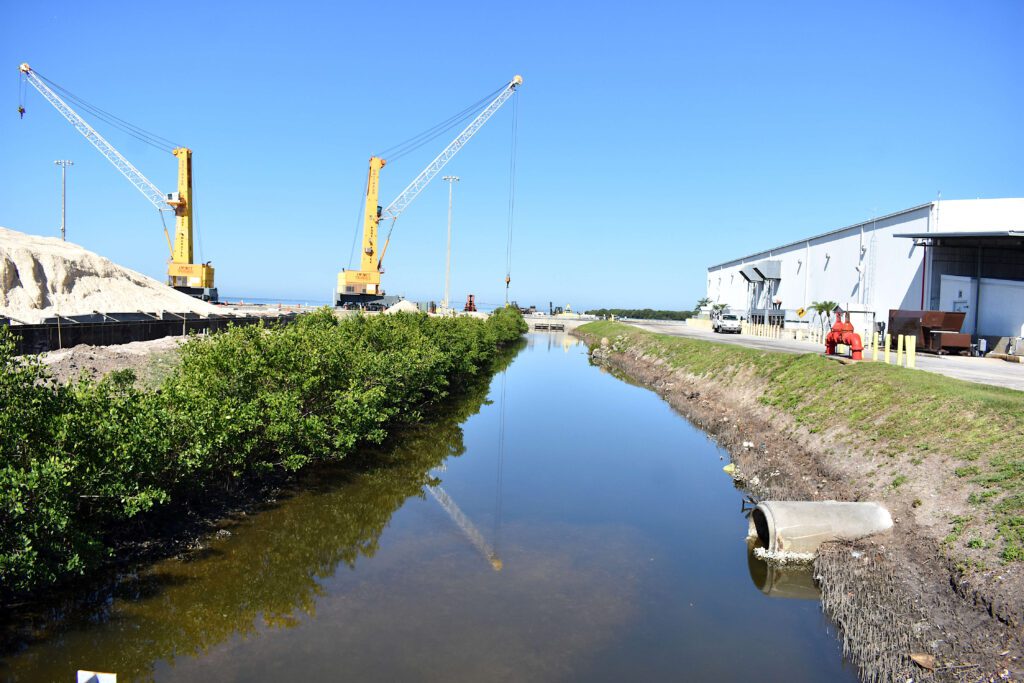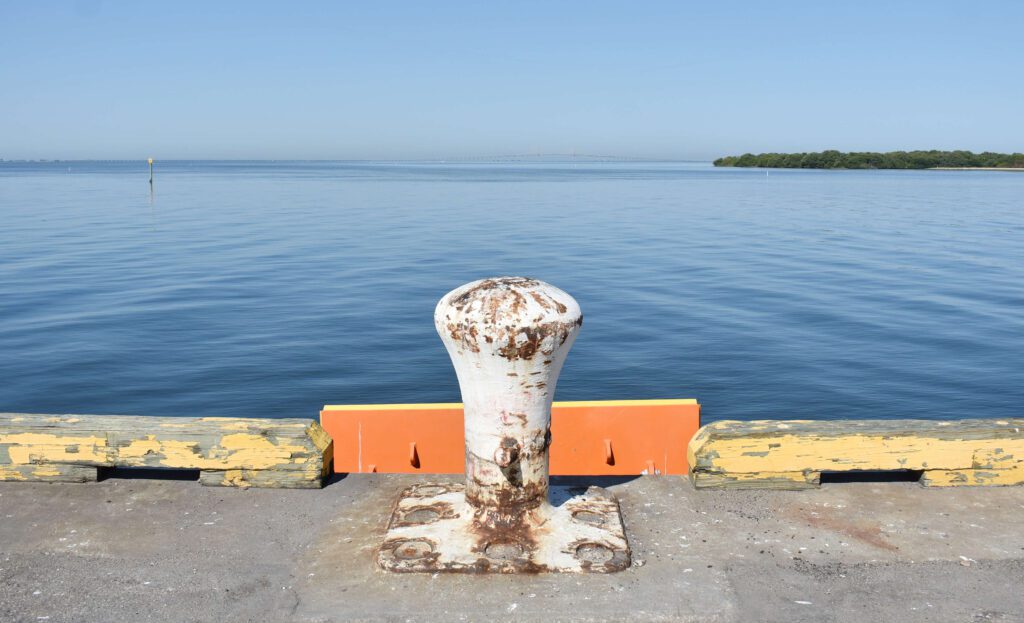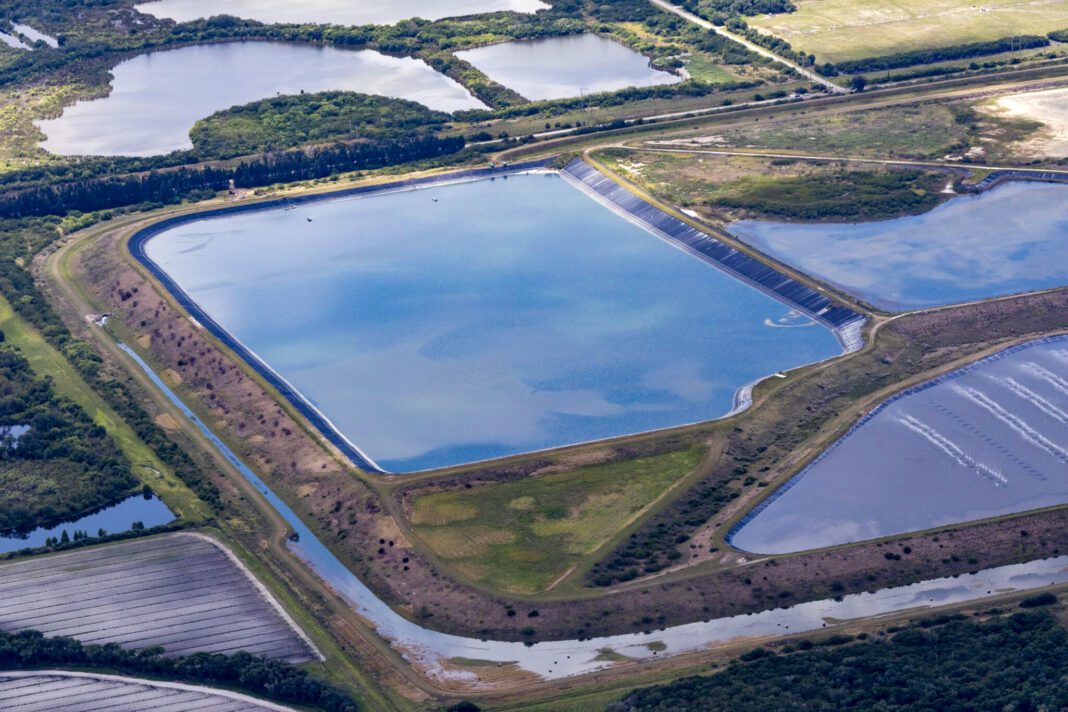PALMETTO – Approximately 4.5 million gallons of stormwater contained in a storage pond at the Piney Point property will soon be discharged into Tampa Bay at Port Manatee (SeaPort Manatee).
The water to be discharged contains elevated levels of salinity (salt) but does not contain the same high levels of nitrogen and phosphate as the Piney Point water discharged into the bay in 2021, according to Piney Point’s receiver.
The Piney Point property is the site of a former phosphate processing plant that closed several years ago. In April 2021, a breach in the outer wall of one of the Piney Point retention ponds, also known as gyp stacks, resulted in approximately 215 million gallons of water containing high levels of nitrogen and phosphate being discharged into the nearby bay. At the time the Piney Point property was controlled by HRK Holdings LLC.
In August 2021, Manatee County Circuit Court Judge Edward Nicholas issued an emergency order appointing Tampa-based business attorney Herb Donica to act as the receiver of the Piney Point site. Under that order, Donica is responsible for maintaining, managing and closing Piney Point “as efficiently and expeditiously as possible.” The order grants Donica judicial immunity from liability, including personal injury and property damage.

When contacted at his Donica Law Firm office Wednesday morning, Donica explained the pending discharge.
“We have four stack systems. The old gyp stack south had been dewatered and was dry. We have gone out for bid with construction companies to do a final closure on it, which is going to be about $10-12 million for construction, materials and a new liner. They want to get started the second week of August,” Donica said. “That stack has to be dry for them to get their machinery in there and start doing the grading. We’re going to change the contour of the stack so it drains completely and will not hold rainwater.”
“The rain that came in June and July has accumulated in that south stack. Our estimate is about four and a half million gallons. By rule, and also by the permit we have, once water goes into a stack, even though it’s rainwater, we have to treat it differently than the water lens on the other side of the stack wall that goes out into our stormwater outfalls on the west side of the property. That water’s been segregated and kept away from the other stacks and materials on the property,” he said.
When asked about the quality of the water to be discharged into the bay, Donica said, “It has higher salinity because it came in contact with the dredge material in the stack that previously came from the bottom of the bay.”
The dredge materials Donica referenced were removed from the Port Manatee waters and transferred to the Piney Point site several years ago as part of a port expansion project.
“The salinity level in the old gyp stack south was measured and it’s right around 19,000 microsiemens. The bay is more like 40,000 microsiemens, which is about twice as much,” Donica said.
“We already take water samples two or three times a day and this water will be sampled even more often. We run our own tests and we also provide samples to FDEP (Florida Department of Environmental Protection) and the county so they can independently test it. This water will constantly be monitored and tested as it goes out,” he added. “We’re looking for two things: the quality of water and whether there are any nutrients in it. If the water gets contaminated, we’ll shut it down. You don’t want the pumps picking up suspended solids and the mud off the bottom of the pond. Our agreement is to discharge water, not dredge materials, suspended solids or mud. We’re working closely with DEP and the Port Authority and we’re in constant contact with them. DEP is in charge of that permit. They need to know what’s going on. If anything should change, they need to know. If we need to halt what we’re doing or go a different direction we will.”

“We expect to start discharging as early as this week,” Donica said. “My site manager is talking to the Port Authority and everyone wants to be present when it starts so everybody gets a chance to test as it’s happening. I don’t know how long it will take. We’ll have two 6-inch pipes up there that will draw from it and into the 36-inch decant loading pipe. It’s a routine thing. It’s been done before, but this summer it’s a little more sensitive because people are more sensitive to what’s going on.”
Regarding his role as the court-appointed receiver of the Piney Point property, Donica said, “I control the property that’s been taken from HRK Holdings and handed over to me. They are gone. I don’t own the property, but I’m in complete possession and I’m entitled to do anything I need to do to achieve the goal of final closure.”
Donica noted he’s not in charge of the deep well injection project Manatee County has embarked upon to discharge the contaminated water in the other gyp stacks to more than 3,000 feet below the earth’s surface.
Additional insight
Dave Tomasko is the executive director of the Sarasota Bay Estuary Program and he’s among the environmentalists and concerned citizens who continue to monitor the Piney Point activities and potential impacts.
Tomasko was contacted July 20 and asked about the pending Piney Point discharge.
“It’s rainwater, but it’s rainwater that’s contacted saltwater. It’s not fresh water, but it’s not full-strength saltwater. It’s brackish water with about one-third to one-half the salt content of the Gulf of Mexico. 19,000 microsiemens is about 10 to 15 parts per thousand. The Gulf of Mexico is probably around 45,000 microsiemens. My understanding is this rainwater came in contact with salt materials and the dredge spoil and it can’t be treated as regular stormwater. The salinity is too high to put it into a creek and would be too high for freshwater organisms,” Tomasko said.
He added that he’s been in contact with Piney Point site manager Jeff Barath and trusts the information Barath’s provided him.
“I’ve been told this is something they’ve done for a decade without any problems. I haven’t seen a lab report, but he told me the nitrogen levels in this water were not a concern. I’ve been told this is not the liquid fertilizer that was discharged last time,” Tomasko said. “What was discharged last time was more than 200 million gallons at a concentration of nitrogen 10 times higher than the worst wastewater treatment plant in our watershed.”

“It’s disappointing that they’re having to discharge again. It reiterates the fact that our backs were against the wall when it came to a solution and the deep well was our only option,” County Commission Chairman Kevin Van Ostenbridge said regarding the pending water discharge.
































